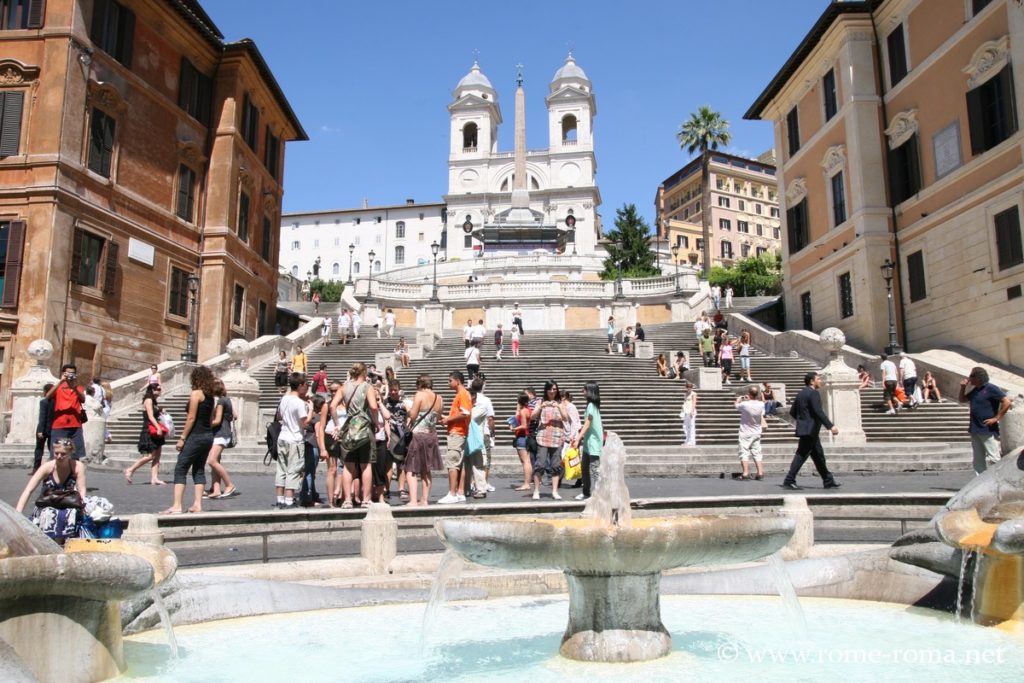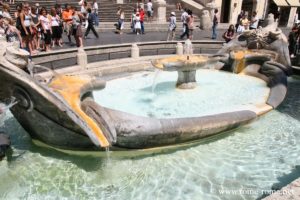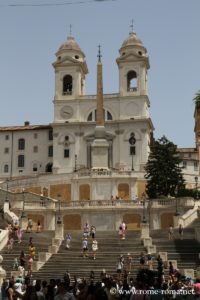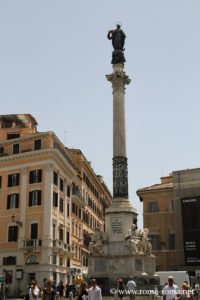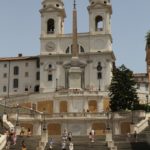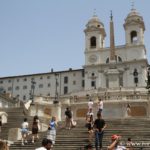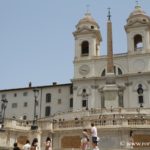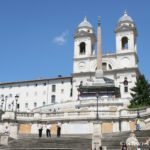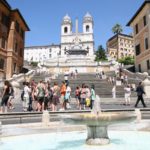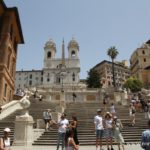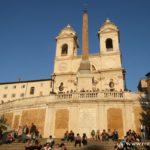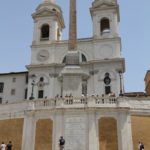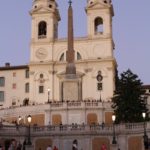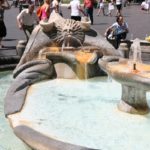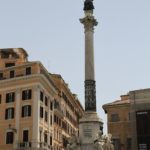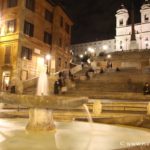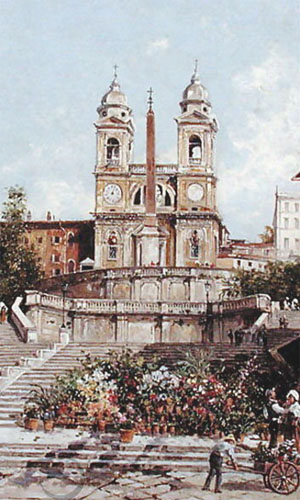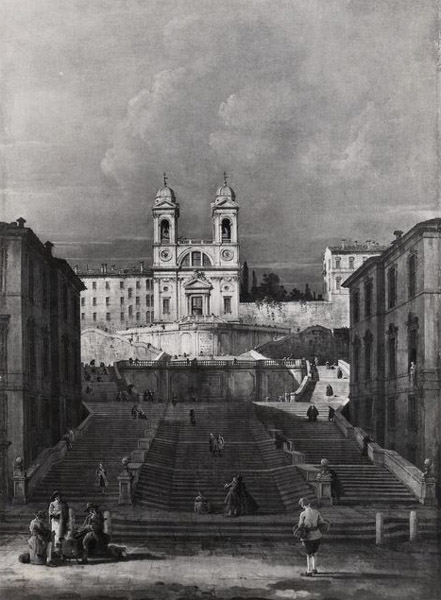In an upscale area of the Rione Colonna, Rome’s Spanish Steps Square (“Piazza di Spagna” in Italian) is one of the most famous squares in Rome and the most original due to its uncommon shape.
It is characterized by the large Baroque staircase of the Trinità dei Monti, a true monument climbing from the Fountain of the Barcaccia up to the obelisk and the beautiful church with its twin bell towers.
The square was called Piazza di Francia (Place of France) in the 17th century. It then took the name Piazza di Spagna due to the historic presence of the Spanish embassy to the Holy See.
The surrounding streets are known for hosting many luxury shops and antique dealers, such as via Condotti, via Frattina, or via del Babuino.
The square, the staircase, and the monuments
The Fountain of the Barcaccia
At the center of the square, the famous Fountain of the Barcaccia (1629) dates back to the early Baroque period. It was sculpted by Pietro Bernini and his son, Gian Lorenzo, known as Bernini.
The monumental staircase
The monumental staircase with 136 steps, in late Baroque style, was commissioned by French Cardinal Pierre Guérin de Tencin, to connect the Spanish embassy to the church of Trinità dei Monti. Funded by France, its construction was entrusted to Alessandro Specchi and Francesco De Sanctis.
It was inaugurated by Pope Benedict XIII on the occasion of the 1725 Jubilee, after generations of debates on how to develop the slope of the Pincian Hill.
This large marble staircase, divided into three parts, is adorned with numerous terraces, which are beautifully decorated with flowers starting in the spring. It was designed so that, as one approaches it, the scenic effect progresses with different perspectives.
John Keats’ House and Tea Room
To the right of the staircase is the house of the English poet John Keats, the Casina Rossa, where he lived and died in 1821. It has been transformed into a museum dedicated to his memory and that of Percy Bysshe Shelley.
To the left of the staircase, the Babington tea room was founded in 1893 by two Englishwomen. It is the oldest tea room in the city.
The Sallustian Obelisk and Trinità dei Monti
In front of the French church of Trinità dei Monti (built in the 16th century and restored in the 19th), there is a beautiful view over the city from the top of the steps. The Sallustian Obelisk stands here, an Egyptian monolith nearly 14 meters high, brought from Egypt to Rome shortly after the time of Augustus, made of red granite from the Aswan quarries. The hieroglyphs appear to have been clumsily copied in Rome around 200 AD from those on the obelisk of Ramses II, installed on the spina of the Circus Maximus, with the names of Seti I and Ramses II. It was originally erected in the Gardens of Sallust, nearby on the Pincian Hill.
The interior of the church is adorned with sumptuous decorations by Daniele da Volterra, a disciple of Michelangelo. Near the church extends the garden of the Villa Medici, now home to the French Academy in Rome. This palace was built in 1570 by Ammannati, the architect of the Florentine Medici family.
Eastern side of the square
On the Via Frattina side, the Palazzo di Propaganda Fide (Palace of the Propagation of the Faith) is a property of the Holy See, built from 1644. The main façade was designed by Bernini, while the side façade is by Borromini.
Opposite this building stands the Column of the Immaculate Conception, inaugurated on December 8, 1857.
Every December 8 since 1923, Rome’s firefighters offer a wreath of flowers to the Madonna during the Feast of the Immaculate Conception. Since 1953, the Pope has regularly attended this ceremony, which has become one of the most popular religious events in Rome, with a mass celebrated by the Pope.
Historical Overview
In 1494, Saint Francis of Paola purchased a vineyard at the top of the current monumental staircase, with the support of King Charles VIII of France, with the goal of building a monastery for the Minim Brothers.
A first part of the Gothic church of Trinità dei Monti was built between 1502 and 1519 by French King Louis XII, next to the monastery. It was later completed by architects Giacomo della Porta and Carlo Maderno.
In 1620, the square became a possession of Spain, which established its embassy to the Holy See there.
In 1629, the Fountain of the Barcaccia was created by sculptor Pietro Bernini (father of Gian Lorenzo Bernini, known as Bernini).
From 1644, the Palazzo di Propaganda Fide (Palace of the Propagation of the Faith) was built on the southern side of the square by Bernini and Francesco Borromini. Since 1622, it has housed the headquarters of the Congregation for the Evangelization of Peoples of the Roman Curia.
At the beginning of the 18th century, the neighborhood became a hotel district, with many hotels and inns to accommodate foreigners.
Between 1723 and 1726, the “scalinata”, the monumental staircase, was built at the initiative of French Cardinal Pierre Guérin de Tencin, by architect Francesco De Sanctis, and inaugurated by Pope Benedict XIII on the occasion of the 1725 Jubilee.
In 1789, the obelisk from the Gardens of Sallust (Horti Sallustiani) was relocated in front of the church of Trinità dei Monti.
The Column of the Immaculate Conception was erected to the south in 1854 by Pope Pius IX, on Piazza Mignanelli adjacent to the Spanish Steps Square.
In the 19th century, the British poet John Keats lived until his death in 1821 in the Casina Rossa, to the right of the staircase.
In 1834, the Hospitallers of Saint John of Jerusalem, of Rhodes and of Malta established their international headquarters at number 68 via Condotti.
In 1893, two Englishwomen founded the Babington’s tea room.
Photo Gallery
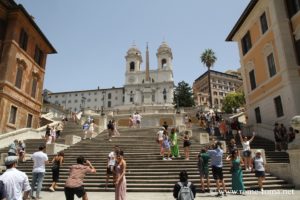

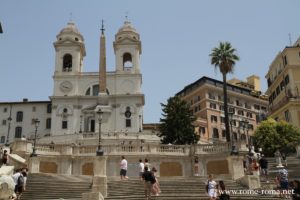
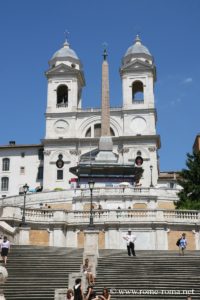
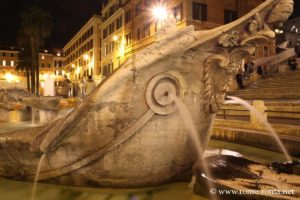
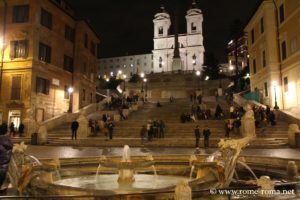
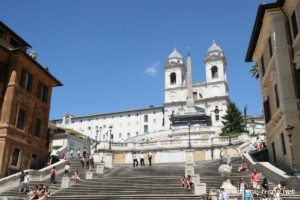
Ancient views in art
Map and address
Address : Piazza di Spagna, 00187 Roma RM, ItalieIf you see this after your page is loaded completely, leafletJS files are missing.
Information
| Piazza di Spagna |
Sources and links to learn more:
|

